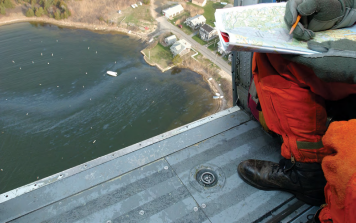Open Water Oil Identification Job Aid for Aerial Observation
An important step in oil spill response is to assess the character and extent of oil spilled on the water. This information is used by the Incident Command (the people in charge of a spill response) to prioritize response and direct cleanup resources. This aid was created to help you perform efficient assessments and to use standard language to communicate your findings effectively.
View and Print the Job Aid: Open Water Oil Identification Job Aid for Aerial Observation [PDF, 8.4 MB]: Updated in August 2016.
Order a Copy: We're sorry, but bound copies of the job aid are no longer being produced.
What's new in this version?
The 2016 version of the Job Aid is a significant revision to previous versions and includes:
- Updated text descriptions
- New graphics
- Improved photos
- An expanded section about False Positives.
The job aid covers these topics:
- Introduction and basic overview of how to visually assess spilled oil.
- Glossary of standard terms used in pollution response.
- Codes you will use to describe oil colors and structure/distribution.
- Chart for visually estimating the percent coverage of spilled oil.
- Thickness and concentration values for each of the oil color codes.
- Checklist for organizing and recording observations of spilled oil.
- Photos showing different types and distributions of oil on water and common response activities, with example text showing how to use standard terminology to describe each scene.
This job aid was originally a joint project of NOAA's Office of Response and Restoration (OR&R) Emergency Response Division (ERD) and the U.S. Coast Guard. Photos were contributed by NOAA, U.S. Coast Guard, Washington Department of Ecology, the Alaska Department of Environmental Conservation, the oil industry, and Alan Allen of Spiltec, who deserves special acknowledgement for sharing his knowledge and vast experience on how best to observe oil from the air.
More Information about Aerial Observation of Oil
Training: Aerial Observation of Oil Spills: Learn about the options that OR&R offers for oil spill aerial observation training.
Aerial Observations of Oil at Sea [PDF, 60 KB]: Read this set of recommended procedures, published in 1996, for assessing spilled oil from the air.
ITOPF: Aerial Observation of Marine Oil Spills: A Technical Information Paper (TIP) on aerial reconnaissance of marine oil spills, produced by the International Tanker Owners Pollution Federation Limited (ITOPF).
More Information about Job Aids
Job Aids for Spill Response: Learn more about the job aids that OR&R has created to help oil spill responders complete their response tasks.
Questions: Contact us with any questions, comments, or suggestions related to NOAA Job Aids.
 An official website of the United States government.
An official website of the United States government. 
